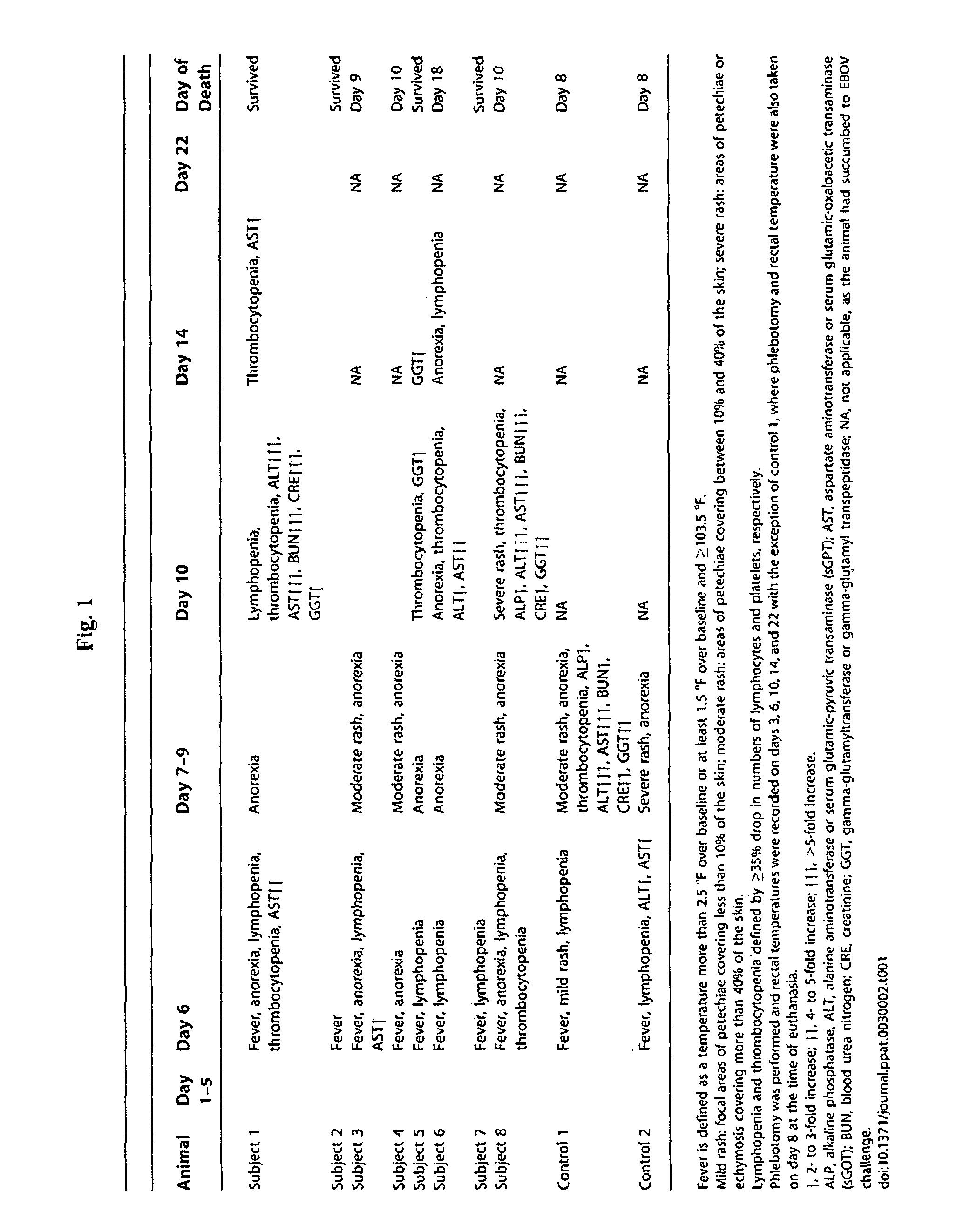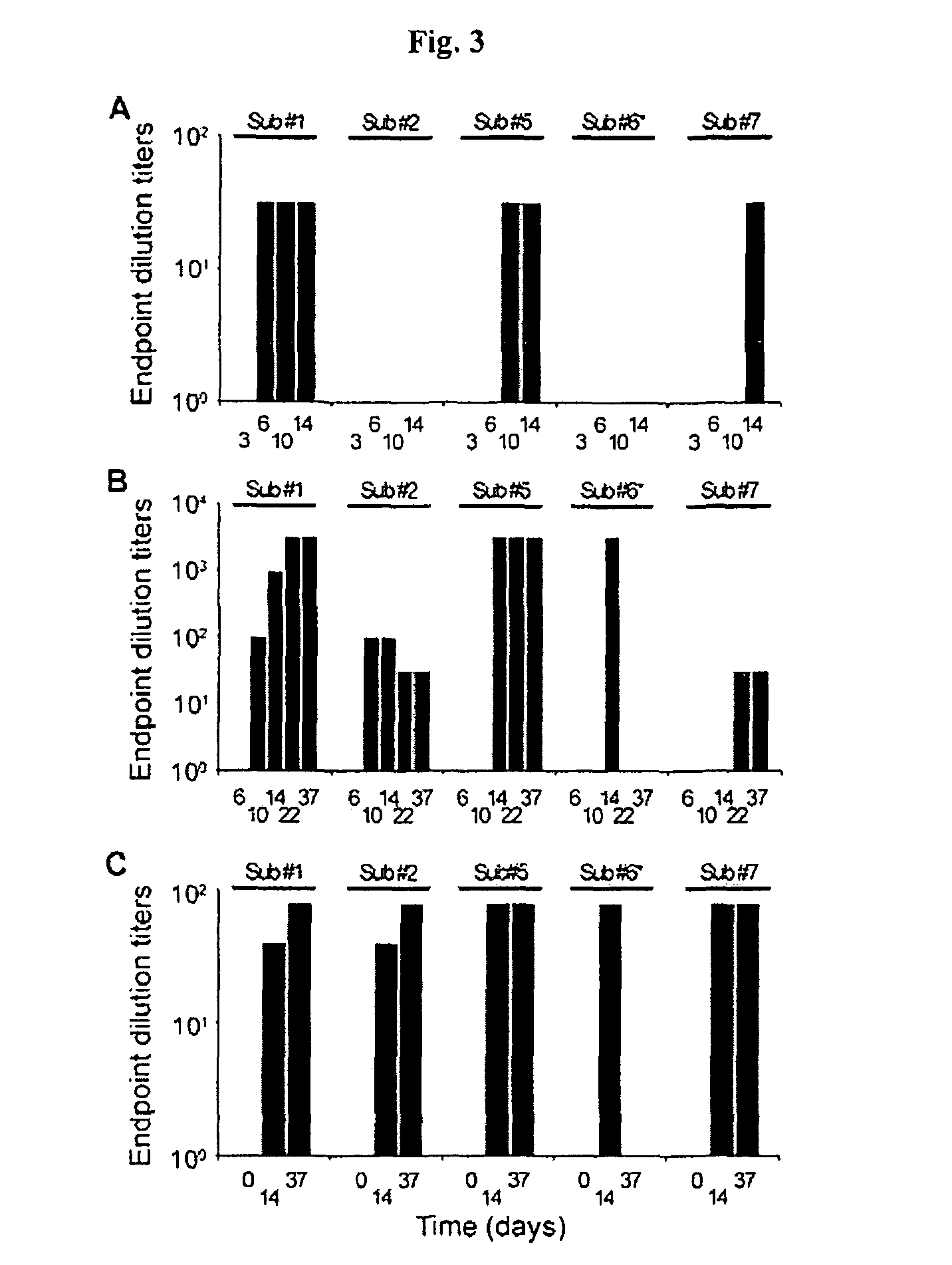Pre-or post-exposure treatment for filovirus or arenavirus infection
a technology of filovirus and arenavirus, applied in the field of preor postexposure treatment of filovirus or arenavirus infection, can solve the problems of risk of developing and risk of developing, and achieve the effect of inhibiting infection
- Summary
- Abstract
- Description
- Claims
- Application Information
AI Technical Summary
Problems solved by technology
Method used
Image
Examples
example 1
Construction of Recombinant Vectors and Virus
[0042]The rVSV expressing the glycoproteins (GP) of MARV strain Musoke (MARV-Musoke), Zaire ebolavirus strain Mayinga (ZEBOV), or Lassa virus strain Josiah were generated as described previously using the infectious clone for the VSV Indiana serotype (see, e.g., Garbutt et al., J Virol. 78: 5458-65, 2004, and Jones et al., Nat Med 11: 786-90, 2005). Specifically, a plasmid containing five VSV genes (nucleoprotein (N), phosphoprotein (P), matrix protein (M), glycoprotein (G), and polymerase (L)), flanked by the bacteriophage T7 promoter sequence, the VSV leader sequence, the hepatitis virus delta virus ribozyme sequence, and the T7 terminator sequence is employed. Between the G and L genes, a unique linker site (Xho-NheI) is present, flanked by a transcriptional start and stop signal for an additional gene to be expressed. The appropriate open reading frames encoding the glycoproteins were generated by PCR, cloned into the VSV genomic vect...
example 2
Hemotology and Serum Biochemistry Analysis Performed in Animal Studies
[0043]Total white blood cell counts, lymphocyte counts, red blood cell counts, platelet counts, haematocrit values, total haemoglobin, mean cell volume, mean corpuscular volume, and mean corpuscular haemoglobin concentration were determined from animal blood samples collected in tubes containing EDTA, by using a laser-based haematology analyzer (Beckman Coulter). The white blood cell differentials were performed manually on Wright-stained blood smears. Serum samples were tested for concentrations of albumin, amylase, alanine aminotransferase, alkaline phosphatase, glucose, cholesterol, total protein, total bilirubin, urea nitrogen, and creatinine by using PICCOLO® Point-Of-Care blood analyzer (Abaxis).
example 3
Virus Detection in Animal Studies
[0044]RNA was isolated from animal whole blood and swabs using appropriate RNA isolation kits (Qiagen). To detect VSV, an RT-PCR assay targeting the matrix gene (nucleotide position 2355-2661, NC—001560) was used. MARV RNA was detected by use of primer pairs targeting the L polymerase gene. The detection limit for this MARV assay is 0.1 plaque-forming units (pfu) / ml of plasma. The amount of infectious MARV was measured by plaque assay on Vero E6 cells from all blood samples. Briefly, increasing 10-fold dilutions of the samples were adsorbed to Vero E6 monolayers in duplicate wells (0.2 ml per well); thus, the limit for detection for this plaque assay was 25 pfu / ml. ZEBOV RNA was detected using primer pairs targeting the L genes (ZEBOV: RT-PCR, nucleotide position 13344-13622; nested PCR, nucleotide position 13397-13590). The sensitivity of the ZEBOV-specific RT-PCR is approximately 0.1 pfu / ml. ZEBOV titration was performed by plaque assay on Vero E6 ...
PUM
| Property | Measurement | Unit |
|---|---|---|
| time | aaaaa | aaaaa |
| composition | aaaaa | aaaaa |
| length | aaaaa | aaaaa |
Abstract
Description
Claims
Application Information
 Login to View More
Login to View More - Generate Ideas
- Intellectual Property
- Life Sciences
- Materials
- Tech Scout
- Unparalleled Data Quality
- Higher Quality Content
- 60% Fewer Hallucinations
Browse by: Latest US Patents, China's latest patents, Technical Efficacy Thesaurus, Application Domain, Technology Topic, Popular Technical Reports.
© 2025 PatSnap. All rights reserved.Legal|Privacy policy|Modern Slavery Act Transparency Statement|Sitemap|About US| Contact US: help@patsnap.com



